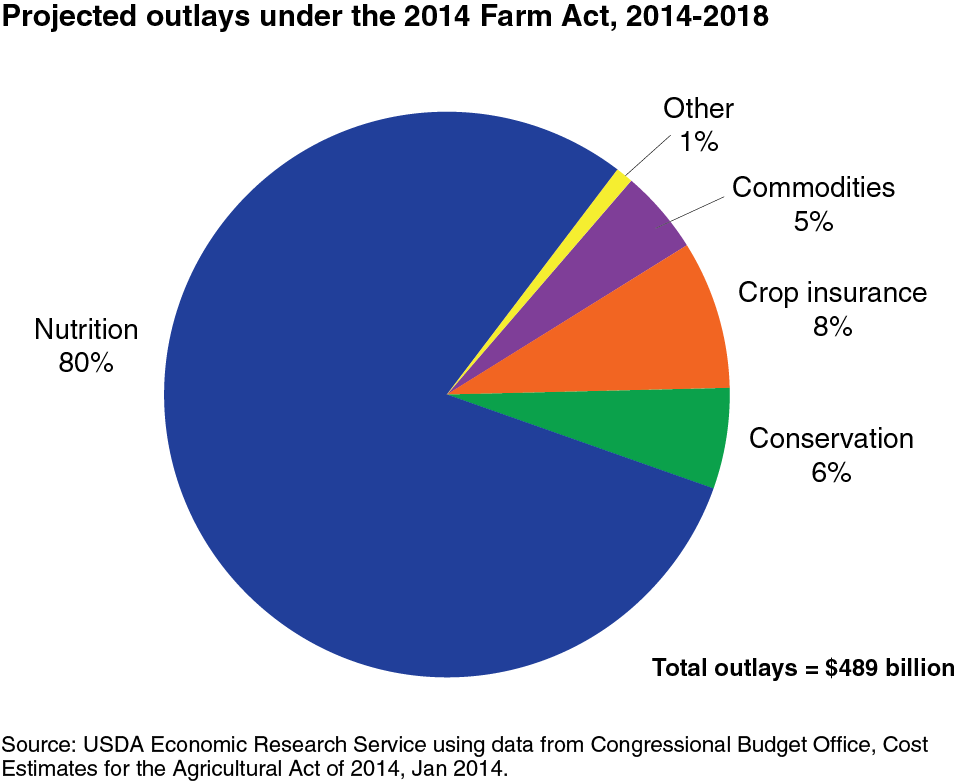The Agricultural Act of 2014 was signed into law on February 7. On the following web pages ERS presents highlights and some economic implications of the new programs and provisions.
The United States addresses agricultural and food policy through a variety of programs, including commodity support, nutrition assistance, and conservation. The primary legal framework for agricultural policy is set through a legislative process that occurs approximately every 5 years.
The current farm law, the Agricultural Act of 2014 (2014 Farm Act), was signed on February 7, 2014, and will remain in force through 2018—and in the case of some provisions, beyond 2018. The 2014 Farm Act makes major changes in commodity programs, adds new crop insurance options, streamlines conservation programs, modifies some provisions of the Supplemental Nutrition Assistance Program (SNAP), and expands programs for specialty crops, organic farmers, bioenergy, rural development, and beginning farmers and ranchers.
The Congressional Budget Office (CBO) projects that 80 percent of outlays under the 2014 Farm Act will fund nutrition programs, 8 percent will fund crop insurance programs, 6 percent will fund conservation programs, 5 percent will fund commodity programs, and the remaining 1 percent will fund all other programs, including trade, credit, rural development, research and extension, forestry, energy, horticulture, and miscellaneous programs.

Topic Area Highlights and Economic Implications
The core research and data program of the Economic Research Service covers the breadth of USDA programs touched by farm legislation: farming, nutrition, conservation, rural development, research, and energy. These webpages provide highlights and summaries of important new programs and provisions, as well as some economic implications of the new farm legislation based on ERS expertise, in the following policy areas.
Crop Commodity Programs (includes provisions from Titles I and XI)
Dairy & Livestock (includes provisions from Titles I and XII)
Conservation (includes provisions from Titles II and XI)
Nutrition (Title IV only)
Rural Development (Title VI only)
Research, Extension, and Related Matters (Title VII only)
Energy (Title IX only)
Crop Insurance (includes provisions from Titles XI and XII)
Specialty Crops (includes provisions from Titles III, IV, VII, and X)
Organic Agriculture (includes provisions from Titles II, VII, X, and XI)
Local and Regional Foods (includes provisions from Titles IV, V, VI, and X)
Beginning Farmers and Ranchers (includes provisions from Titles II, V, VI, VII, XI)
Socially Disadvantaged and Veteran Farmers and Ranchers (includes provisions from Titles II, V, VI, VII, and XII)
ERS Policy-Related Research
The core research and data program of the Economic Research Service covers the breadth of USDA programs touched by farm legislation: farming, nutrition, conservation, rural development, research, and energy.
See recent research focusing on these issues.
See also:
2008 Farm Bill: Side-by-Side Comparison with Previous Law
2008 Farm Bill: Background Publications
The 2002 Farm Bill: Provisions and Economic Implications
For further information:
USDA Farm Bill Page
Congressional Research Service 2014 Farm Bill side-by-side comparison
